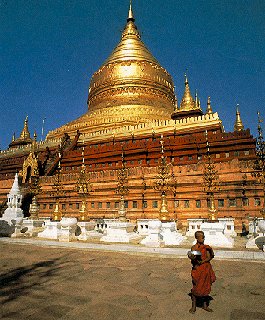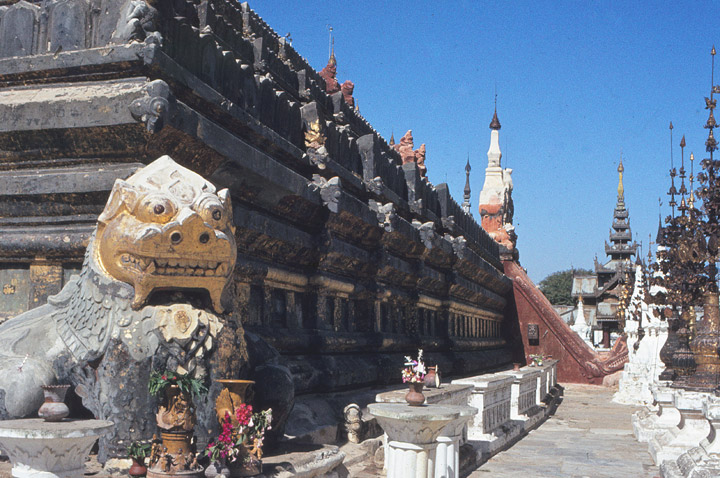In this plan there is a floor plan that projects lines down to make the section cut.
Tuesday, February 28, 2012
Monday, February 27, 2012
IAR 221: Power Kingdom: Shwezigon Pagoda
Power Kingdom
- In the 12th century the Pagan ruled over Myanmar.
- The Pagan religion was Buddhism, but they adopted the Hindu way.
- Location: Southeast Asia.
- Monarch system.

Shwezigon Pagoda
The Shwezigon Pagoda Kingdom was considered a powerhouse in Southeast Asia. The capital that the kingdom was located in is Arimaddanapura. To the Pagans this grand kingdom wasn't nearly enough. Shortly after they begin building smaller temples around the structure, which gave it more significance.

Front view: Shwezigon Pagoda
At the top of the structure is a tall sort of pointed dome. From looking at the city it is obviously one of the tallest structures in the city. Its very reminiscent of a "wu wu", which is based off of who is the most dominant. While observing the structure I also noticed that in this picture it is lighted at night. This adds a extra characteristics to the dominance of the structure.



Decoration around the Shwezigon Pagoda
Along the Shwezigon Pagoda there are motifs and decoration. The decoration is there for aesthetics, but the motifs are there to tell a story. In these walls are tales about Buddha. There are also excerpts from the Buddhists text. These didactic panels were clear evidence of the religion of the Pagans. Carving faith in stone was not limited to just certain parts of the world. The influence stretched as far as Asia.
Sources
A Global History of Architecture. Ching, 396-397
Thursday, February 23, 2012
Tuesday, February 21, 2012
IAR 221: Faith in Architecture
Power & Faith in Architecture
·
Located in Jerusalem.
·
Completed in 691CE.
·
Octagonal floor plan.
Dome of Temple Mount, Jerusalem
Temples throughout history
have always displayed power in architectural forms. One way this temple
displays power is through the gold dome on the very top. This is basically the
central focus of the temple through plan and through what it encloses.
Underneath the dome lies the foundation stone. The foundation stone is believed
to be the underpinning on which the world was created.(Ching, 302).
The octagonal shape of the
plan has been used a lot in baptisteries. Within the octagonal shape lies a
series of circles, piers, and columns that support the large dome.
Observing this structure for
the first time is a bit intimidating. I feel that size and forms of temples enforces
a little fear into the people who worship within them. It helps them stay on
the path to righteousness. The oldest structure which contains a dome is the
Pantheon. I believe this structure was precedence for structures to come and
structures we have in our modern times.
Indoor football stadiums come
to mind when I think of structures with domes. I always thought they placed
domes on the stadium to resemble the shape of a football, but in actuality
domes are everywhere in our history.
Top view of Temple Mount
Front view of Temple Mount, Jerusalem \
Sources
Wednesday, February 15, 2012
IAR 221 Foundations
Throughout history evidence that architectural design comes
from previous or natural design is very significant. Theses designs might have
double meanings, maps of meanings, and subcultural meanings. These ideas were
presented by Dick Hebdige. For example The University of Greensboro is a school
where people go to get an education and hopefully someday graduate. That would
be the obvious meaning of the school. In my opinion the double meaning of UNCG
could be that it’s a place for a new life or new experience. When observing the
maps of meaning aspect, you would analyze how UNCG relates to Greensboro. How
does UNCG affect Greensboro as a whole? It would make Greensboro sort of a
college community. Last but not least when analyzing the subcultural meaning of
UNCG, you might want to go into the history of the building. UNCG used to be a women’s
college before it became co-ed. What meanings lie beyond that?
Other material culture aspects that are valuable to consider
are description, deduction, and speculation. Describing an object, space,
building, or place you want to use formal analyzes. This includes looking at
things such as color, shape, texture, cultural meanings, etc. When using deduction, you take into
consideration how it makes you feel or what emotional/sensory response you
obtain from it. Lastly when speculating you want to use creative out of the box
thinking. These three ways of analyzing were presented by Jules David Brown.
These basic building
blocks such as groves, stacks, and circles acted as prototypes for structures
like Stonehenge in 3000 BCE. Groves, circles, and stacks are elements that are
found in nature. The three basic elements aided in constructing architectural
spaces. Some objects included two qualities, qualifying these objects as
hybrids. From groves the delightful columns were constructed. The archetype
selection includes Doric, Ionic, and Corinthian. The structures of Greece took
from these primitive aspects and built structures such as the Parthenon and the
Colosseum. The Parthenon’s porch consist of columns that give the structure
firmness, whereas for the Colosseum they’re just for aesthetics. Romans adopted
aspects of Greek design and developed their cities.
The Romans had a variety of different design elements as
well as building structures. Buildings such as the Colosseum, Basilica, and Amphitheatre
all display arches and domes. These two structures of design were very popular
during the Roman era. Not only are arches and domes aesthetically pleasing to
the eye, but they also give a different type of stability other than just post
and lintel. The most important structure that ran through Rome was the
aqueducts that carried water into the city. The arcades along the aqueducts
allowed them to be built along greater distances so the romans could have fresh
clean water. The city of Rome was built on a grid that had main roads that
crossed and a certain point. This is called cardo and decumanus. The Romans
also had to modify plans to accommodate geography.
In our modern day society we continue to analyze ancient
designs and use them as the foundations of our civilization.

Monday, February 13, 2012
Thursday, February 9, 2012
IAR 221: Dark Tunnel
The value of your structured walls.
Where does your tunnel lead.
Is there color at the end?
Or does it lead to nothing?
Layer upon layer tells many stories.
The depth of your wisdom is beyond understanding.
Monday, February 6, 2012
IAR 221 The Delight of College Ave.
When viewing circles around the world it makes me wonder why this shape is so important and how it became popular all around the world. Going along with Cory's post about the golden arches being derived from Roman culture, we have to accept that all the symbols and shapes that we know are from ancient cultures and nature.
Subscribe to:
Posts (Atom)












.JPG)
.JPG)













